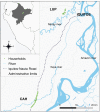Anti-MSP-10 IgG indicates recent exposure to Plasmodium vivax infection in the Peruvian Amazon
- PMID: 31770108
- PMCID: PMC7030819
- DOI: 10.1172/jci.insight.130769
Anti-MSP-10 IgG indicates recent exposure to Plasmodium vivax infection in the Peruvian Amazon
Abstract
BACKGROUNDSerological tools for the accurate detection of recent malaria exposure are needed to guide and monitor malaria control efforts. IgG responses against Plasmodium vivax and P. falciparum merozoite surface protein-10 (MSP10) were measured as a potential way to identify recent malaria exposure in the Peruvian Amazon.METHODSA field-based study included 470 participants in a longitudinal cohort who completed a comprehensive evaluation: light microscopy and PCR on enrollment, at least 1 monthly follow-up by light microscopy, a second PCR, and serum and dried blood spots for serological analysis at the end of the follow-up. IgG titers against novel mammalian cell-produced recombinant PvMSP10 and PfMSP10 were determined by ELISA.RESULTSDuring the follow-up period, 205 participants were infected, including 171 with P. vivax, 26 with P. falciparum, 6 with infections by both species but at different times, and 2 with mixed infections. Exposure to P. vivax was more accurately identified when serological responses to PvMSP10 were obtained from serum (sensitivity, 58.1%; specificity, 81.8%; AUC: 0.76) than from dried blood spots (sensitivity, 35.2; specificity, 83.5%; AUC: 0.64) (PAUC < 0.001). Sensitivity was highest (serum, 82.9%; dried blood spot, 45.7%) with confirmed P. vivax infections occurring 7-30 days before sample collection; sensitivity decreased significantly in relation to time since last documented infection. PvMSP10 serological data did not show evidence of interspecies cross-reactivity. Anti-PfMSP10 responses poorly discriminated between P. falciparum-exposed and nonexposed individuals (AUC = 0.59; P > 0.05).CONCLUSIONAnti-PvMSP10 IgG indicates recent exposure to P. vivax at the population level in the Amazon region. Serum, not dried blood spots, should be used for such serological tests.FUNDINGCooperative agreement U19AI089681 from the United States Public Health Service, NIH/National Institute of Allergy and Infectious Diseases, as the Amazonian International Center of Excellence in Malaria Research.
Keywords: Diagnostics; Epidemiology; Immunology; Infectious disease; Malaria.
Conflict of interest statement
Figures






References
-
- World Health Organization. World Malaria Report 2016. World Health Organization website. https://www.who.int/malaria/publications/world-malaria-report-2016/repor... Accessed December 2, 2019.
Publication types
MeSH terms
Substances
Grants and funding
LinkOut - more resources
Full Text Sources
Research Materials

